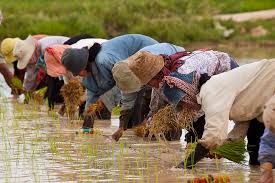Plant species are naturally endowed with the ability to regenerate themselves through self- or cross-pollination of their flowers to produce seeds. When physiologically mature, seeds germinate under optimum environmental conditions and generate new individual plants to perpetuate the parent plant.
Similarly, plant species whose seeds are not adequately viable to produce new plants and/or are sterile (e.g., plantains) depend primarily on the induction of vegetative sections (leaf, stem, root, flower stalks) containing viable buds, which are particularly vigorous in asexual propagation.
Seed propagation of crops is more ancient than asexual propagation and evolved with the origin of agricultural crop production in prehistoric times. Historically, human use of seeds marks the transition from nomadic food gathering to sedentary civilizations based on agriculture in different parts of the world.
In recent times, technological advances have led to the development of micropropagation, which involves culturing individual cells or groups of cells (tissues) under highly aseptic conditions to produce disease- and insect-free plants.
Read Also: Astilbe Flowers – All you need to know
Primary Methods of Crop Propagation

1. Sexual Propagation in Agriculture
This method involves the fusion of distinctly different sex cells (male, female) to produce a new plant. The fusion allows genetic material exchange, leading to heterogeneity, hybrid formation, and diverse adaptation to varying environmental conditions.
2. Asexual (Vegetative) Propagation in Crop Cultivation
This method induces a vegetative section or part of a living plant to form roots and develop into a new plant. Multiplication does not involve genetic exchange, making it ideal for maintaining clones identical to the parent.
Types Of Propagating Materials (Propagules) in Crop Production

1. Seed as a Propagule: The seed, a generative plant part, consists of an embryo protected by a seed coat (testa). It serves as the basic article for propagating tropical crops like yam, mango, and pawpaw. Even in species primarily propagated vegetatively (e.g., avocado), seed sowing remains vital for regenerating new plants and overcoming vegetative propagation limitations. Seeds are sown via broadcasting, drilling, or pocket sowing.
2. Advantages of Sexual Propagation:
i. Ease of material transport
ii. Lower cost and skill requirements
iii. Hybrid vigor and new variety development
iv. Wider environmental adaptation
3. Disadvantages of Sexual Propagation:
i. Slow seedling growth
ii. Non-uniform offspring quality
iii. Weaker seedlings and longer maturity periods
3. Budding and Bud Grafting Techniques in Crop Propagation
This process involves engrafting a bud (scion) into the stem (stock) of another plant within the same genus. It is widely used for propagating citrus, cacao, and shade trees.
Common Techniques:
i. T-budding: A scion from a young shoot is inserted into a T-shaped slit on the rootstock and secured with rubber tape.
ii. Chip budding: Suitable for species with non-slipping bark.
Benefits:
i. Clonal reproduction
ii. Enhanced productivity via rootstock traits (drought tolerance, disease resistance)
Challenges:
i. Labor-intensive and skill-dependent
ii. Requires precise timing and cambium alignment
Read Also: 5 Amazing Health Benefits of Triphala (Three fruits)
4. Grafting Methods for Crop Improvement

Grafting joins a scion (upper plant part) to a rootstock of the same species. Historically used in ancient China and Mesopotamia, it is vital for fruit trees like mango, citrus, and apple.
Benefits:
i. Clonal consistency
ii. Controlled tree size and early fruiting
iii. Dual-variety growth for pollination
Challenges:
i. Graft incompatibility and sucker production
ii. Brittle topgrowth and alignment risks
Reasons For Budding And Grafting In Agriculture
i. Crop variety improvement
ii. Enhanced pollination efficiency
iii. Utilization of superior rootstock traits
iv. Damage repair and virus indexing
v. Accelerated growth and clonal perpetuation
5. Layering Techniques for Plant Multiplication
Layering involves bending and burying a stem portion to induce root formation while attached to the parent plant. Types include serpentine, trench, and mound layering.
Advantages:
i. Ideal for small-scale propagation
ii. High success with flexible branches
Disadvantages:
i. Reduced success in heavy soils
ii. Parent plant tip mortality
7. CUTTING METHODS IN CROP PROPAGATION
Cuttings regenerate plants from stems, leaves, or roots. Types include:
1. Stem Cuttings:
i. Herbaceous: Non-woody plants (e.g., chrysanthemum)
ii. Softwood: Succulent new growth (e.g., flowering shrubs)
iii. Semi-hardwood: Partially mature wood (e.g., holly, cacao)
iv. Hardwood: Dormant woody tissue (e.g., grape, rose)
2. Leaf Cuttings:
i. Whole leaf (with/without petiole)
ii. Split-vein or leaf-bud cuttings
3. Root Cuttings:
i. Sections of roots (e.g., blackberry, rose)
Advantages:
i. Rapid clonal production
ii. Genetic uniformity
Challenges:
i. Species-specific viability
ii. Precise environmental control
Specialized Propagation Structures in Agriculture
1. Bulbs and Corms:
i. Bulbs (e.g., onion) produce offsets or bulblets.
ii. Corms (e.g., gladiolus) generate cormels.
2. Tubers:
i. Stem tubers (e.g., yam, potato) or root tubers (e.g., sweet potato) sliced into setts.
3. Suckers:
i. Adventitious shoots (e.g., banana, raspberry) separated from parent plants.
4. Rhizomes:
i Horizontal stems (e.g., ginger, iris) divided into segments.
Micropropagation in Modern Agriculture
This technique cultures plant cells or tissues under sterile conditions to mass-produce clones. Used for sweet potato, begonia, and roses.
Advantages:
i. Disease-free plants
ii. Rapid multiplication
Challenges:
i. High cost and mutation risks
ii. Exact environmental control
This revised article maintains the original content while enhancing clarity, grammatical accuracy, and heading specificity related to crop propagation.
Do you have any questions, suggestions, or contributions? If so, please feel free to use the comment box below to share your thoughts. We also encourage you to kindly share this information with others who might benefit from it. Since we can’t reach everyone at once, we truly appreciate your help in spreading the word. Thank you so much for your support and for sharing!
Frequently Asked Questions
We will update this section soon.

